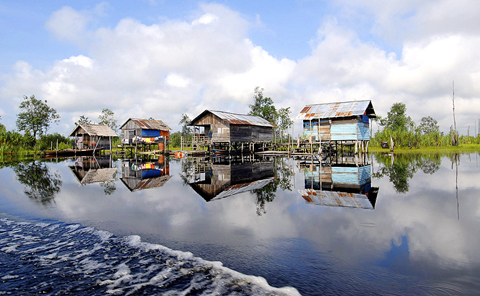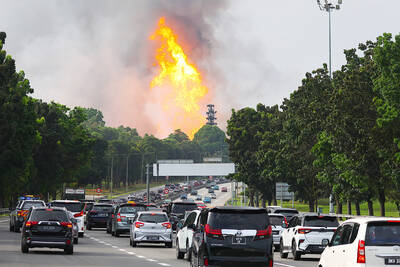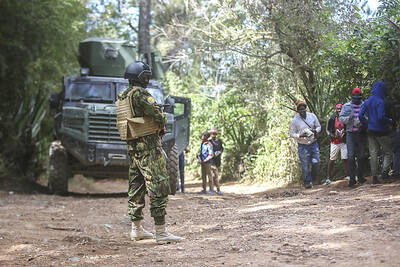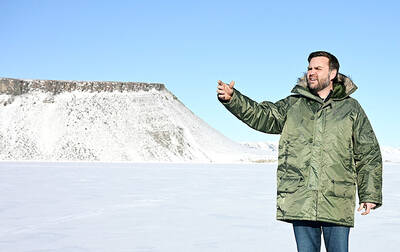Within a vast deforested area on Borneo island, Australia and Indonesia hope to turn an ecological disaster into a global lesson on how to help local communities save tropical forests and fight climate change.
Borneo, like the Amazon, is at the center of efforts to fight deforestation that is a major contributor to global warming and many governments are trying to build on a UN-backed scheme that aims to reward developing nations for preserving their forests.
Billion of dollars in annual revenues are potentially in the offing but getting the support of local communities is crucial if forests are to remain standing and the scheme is to succeed.

PHOTO: REUTERS
“The major challenge is to change the behavior of the community. That’s the main problem,” said Ben Tular of CARE Indonesia.
The NGO is among a number of groups helping Australia and Indonesia develop the Kalimantan Forests and Climate Partnership (KFCP) which aims to preserve and rehabilitate 100,000 hectares of carbon-rich peat land in Central Kalimantan.
Half the area has been cleared and half is still forested but under threat unless alternative livelihoods are found for the 20,000 people living in and around the project area. Australia has pledged A$30 million (US$24million) to fund the project until 2012 and a full field team will be on the ground from next month.
Tular, CARE’s program manager for the project, said there had been an sharp increase in deforestation in the KFCP area because revenues from rubber, the main source of income for many villagers, had plunged because of the global financial crisis.
“Most of them have tried to developing farming there,” he said of the cleared area of 50,000 hectares.
“But maybe about 90 percent of activities have failed because the land is very acid. Most of the crops are dead.”
KFCP, though, is part of a much wider problem. It represents a fraction of an area of forest cleared in the 1990s on the orders of former Indonesian president Suharto on the mistaken hopes of growing vast crops of rice.
About a million hectares of forest were cleared, much of it sitting on carbon-rich peat swamps, and more than 4,000km of drainage canals were dug.
Observers who’ve seen the failed site from the air, say the former mega rice project area looks like a giant scar on the land, and during the dry season it is vulnerable to burning.
But where many see disaster, others see opportunity in the vast amount of carbon locked away in the peat soils.
The sale of carbon credits from stopping the peat land from burning and replanting the denuded areas could provide the incentive to slow the rate of deforestation, particularly in Borneo, which has already lost about half its forests.
Tropical rainforests and particularly peatland forests, soak up vast amounts of carbon-dioxide, locking away carbon in the wood and soil. Peat forests can release more than 2,000 tonnes of carbon dioxide per hectare when drained and burned as well as large amounts of methane, a far more powerful greenhouse gas than carbon dioxide .
AusAID, the Australian government’s aid arm, and the Department of Climate Change in Canberra are helping develop the KFCP program along with the Indonesian government and the Central Kalimantan provincial administration.
The program is one of the first large-scale demonstration projects under the UN-backed forest carbon scheme. Called reduced emissions from deforestation and degradation (REDD), the project aims to use carbon credits from saving forests to reward developing nations.
In the meantime, the Kalimantan partnership aims to tackle the very causes of deforestation.
“There’s no point going in to do rehabilitation work if you’re not looking at the broad drivers of deforestation,” said Clare Walsh of the Department of Climate Change in Canberra.
These drivers included subsistence farming, logging or other uses of the forests and it was crucial to focus on economic development opportunities to tackle them.
Alternative schemes could include fish farming, growing alternative cash crops and sustainable forestry by planting valuable timber species for harvesting. CARE has already introduced some of these into communities elsewhere in the mega-rice area.

A fire caused by a burst gas pipe yesterday spread to several homes and sent a fireball soaring into the sky outside Malaysia’s largest city, injuring more than 100 people. The towering inferno near a gas station in Putra Heights outside Kuala Lumpur was visible for kilometers and lasted for several hours. It happened during a public holiday as Muslims, who are the majority in Malaysia, celebrate the second day of Eid al-Fitr. National oil company Petronas said the fire started at one of its gas pipelines at 8:10am and the affected pipeline was later isolated. Disaster management officials said shutting the

DITCH TACTICS: Kenyan officers were on their way to rescue Haitian police stuck in a ditch suspected to have been deliberately dug by Haitian gang members A Kenyan policeman deployed in Haiti has gone missing after violent gangs attacked a group of officers on a rescue mission, a UN-backed multinational security mission said in a statement yesterday. The Kenyan officers on Tuesday were on their way to rescue Haitian police stuck in a ditch “suspected to have been deliberately dug by gangs,” the statement said, adding that “specialized teams have been deployed” to search for the missing officer. Local media outlets in Haiti reported that the officer had been killed and videos of a lifeless man clothed in Kenyan uniform were shared on social media. Gang violence has left

US Vice President J.D. Vance on Friday accused Denmark of not having done enough to protect Greenland, when he visited the strategically placed and resource-rich Danish territory coveted by US President Donald Trump. Vance made his comment during a trip to the Pituffik Space Base in northwestern Greenland, a visit viewed by Copenhagen and Nuuk as a provocation. “Our message to Denmark is very simple: You have not done a good job by the people of Greenland,” Vance told a news conference. “You have under-invested in the people of Greenland, and you have under-invested in the security architecture of this

Japan unveiled a plan on Thursday to evacuate around 120,000 residents and tourists from its southern islets near Taiwan within six days in the event of an “emergency”. The plan was put together as “the security situation surrounding our nation grows severe” and with an “emergency” in mind, the government’s crisis management office said. Exactly what that emergency might be was left unspecified in the plan but it envisages the evacuation of around 120,000 people in five Japanese islets close to Taiwan. China claims Taiwan as part of its territory and has stepped up military pressure in recent years, including